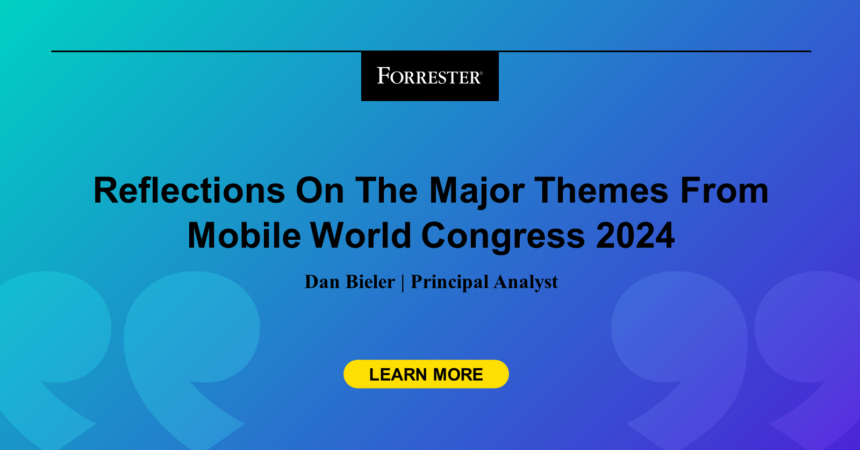With 101,000 in-person attendees, Mobile World Congress (MWC), one of the most important annual tech events in Europe, nearly returned to pre-pandemic attendance levels. The event had great energy and positivity and was very well received. In 2024, MWC was about all tech topics, beyond just telco themes. MWC ‘24 felt more like a B2B than B2C event and was dominated by the big themes of AI and APIs. I have now had some time to reflect on these MWC themes, and my observations are that:
- The ServeCo vs. NetCo debate is still ongoing. NetCos focus on the network platform play, driven by cost reduction and infrastructure consolidation potential, exemplified by Nokia and Ericsson’s efficiency efforts. Ownership of national network infrastructure is debated amid increasing national security concerns. Regulation will heavily influence NetCos’ future, with models such as the UK’s Openreach and Australia’s nbn (National Broadband Network) serving as examples. ServeCos, on the other hand, emphasize the API play, requiring telcos to shift toward network-aware applications and expanded services. Asian carriers like Axiata and Jio are leading this evolution. A holding structure, as explored by Liberty Global, could integrate both ServeCo and NetCo models under one umbrella.
- Carriers are pursuing deeper alliances for their telco API initiatives. The GSMA Open Gateway initiative, operating under the CAMARA framework, facilitates standardized telco APIs, forming an ecosystem of 47 carriers covering 65% of global connections. With nearly 100 network APIs, CAMARA enables universal access for developers, aiming to ensure consistent service delivery across carrier networks. It accelerates service deployment and supports software-as-a-service providers. Network APIs empower developers with capabilities such as SIM swaps and quality-on-demand connectivity, fostering innovation and revenue opportunities. Success depends on effective carrier collaboration and overcoming challenges related to monetization and traditional payment mindsets.
- Clouds are “blowing” into the network core and the RAN. Carriers are adapting to a service-oriented and flexible cost base, collaborating closely with hyperscalers like AWS, Azure, and Google. Network equipment vendors and emerging cloud-based providers are also shaping the landscape. Cloud RAN is part of this evolution, aiming for a fully open agile network. Carriers increasingly expect open RAN options from vendors but remain cautious about operational changes. Traditional carrier mindsets pose hurdles to network advancements, emphasizing the need for openness to change and stronger partnerships. Network cloudification, a long-term process, prompts carriers to reevaluate strategies amid rising public cloud costs and total cost of ownership concerns.
- The potential for carrier-hyperscaler competition is growing. Relationships between carriers and hyperscalers will be redefined by the network cloudification trend. As hyperscalers are pushing to deploy public cloud solutions inside core and radio access networks as well as OSS and BSS, this poses risk to the carriers’ value propositions. There is nothing inevitable about hyperscalers eating the carriers’ lunch. But hyperscalers need to be careful not to abuse their increasingly powerful position vis-à-vis the carriers. Regulators are likely to focus more on the relationship between hyperscalers and carriers as networks become more cloudified, not least from a national security perspective.
- AI and genAI will play a much greater role for telcos going forward. Telcos have integrated AI into network lifecycle management, focusing on automation to fine-tune hardware and software for energy efficiency and reliability. AI’s role is expanding in network assurance, zero-touch operations, and edge applications. Generative AI (genAI) is emerging in telcos, initially focusing on service empowerment and support through examples such as Ask Telstra and SK Telecom’s A. Deutsche Telekom’s T Phone with Brain.ai and Qualcomm represents a step toward app-free AI phones. Telco large language models are facilitating effective internal knowledge base searches for employees and will increasingly enable intent-based network management, as seen with Aira RANGPT and NetMaster. The AI-RAN Alliance, launched at MWC ‘24, aims to transform radio infrastructure using AI to optimize RAN asset utilization and QoS, as well as unlock new revenue streams. Key members include Ericsson, Nokia, Samsung, Microsoft, and AWS, focusing on spectral efficiency, RAN operational efficiency, digital twins, and AI readiness for 5G and 6G RAN evolution.
- Stratosphere network coverage is emerging as an additional network “channel.” High-altitude platform stations (HAPS) have been around for decades, but interest in them is growing, as they potentially offer interesting opportunities for carriers to “plug holes’’ in their broadband network coverage. HAPS, like fixed-wing aircraft-type vehicles, circulate at about 60,000 feet above ground, which in space terms is “a stone’s throw away,” and they can stay there for weeks. This makes them essentially a “cell tower in the sky” and enables direct links to phones on the ground — unlike LEO, MEO, or GEO constellations. HAPS cover about a 400-km. radius with around 250 cell towers. Hence, key HAPS players like AALTO, Aerostar, or Stratospheric Platforms unlock several needs for mobile network operators, such as supporting very low latency and high bandwidth, providing direct-to-handset connectivity, and offering cost-effective connectivity for underserved, rural, blue-light/military, and disaster recovery usage scenarios.
Forrester clients can connect with me through an inquiry or guidance session to discuss these topics in more depth.







